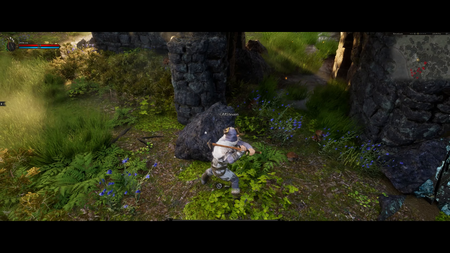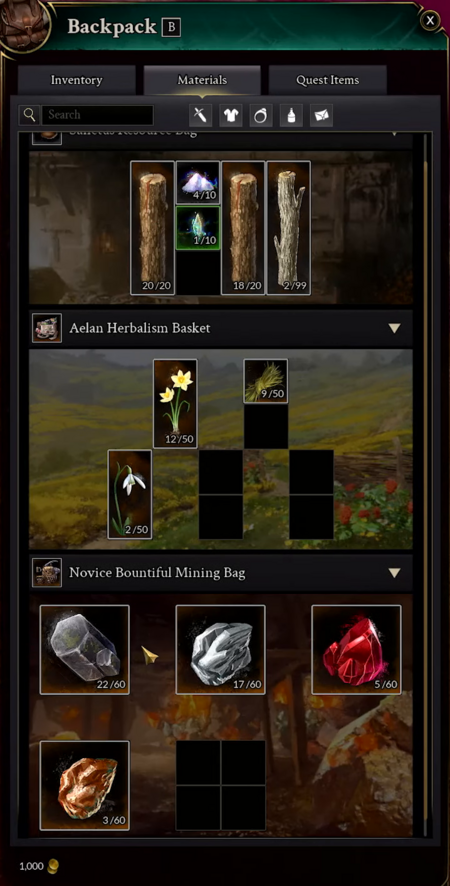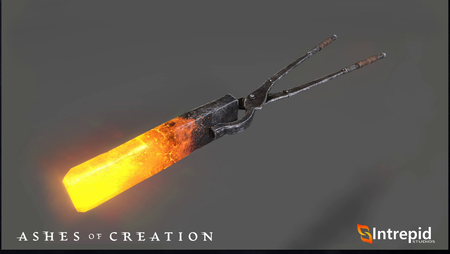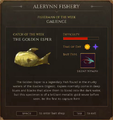Sammeln
The first major reveal is that in Ashes of Creation we have now expanded the resource gathering system to include a great many of what the world is showing you of these resources. So when you see a tree, you can chop a tree. If you see a rock, you can mine a rock.[1] – Steven Sharif
Sammeln is one of the artisan classes in Ashes of Creation.[4][5]
- Many of the visible resources (such as Trees and Ore) in the open world are gatherable.[1]
- The exact type of resource present within a resource node is not known until the node is harvested.[3]
- There's a bunch of different things in Ashes that will be gatherable. We have plants and trees and rocks and fish and animals and creatures that can be tamed; and we're thinking to reach the visual fidelity bar and to have things a little bit more rooted in what we know is that it wouldn't really make sense for you to just see gold all over the world in the same way that you would plants and trees; so we wanted to get feedback on what players think about some of the different gatherable types having different things that you would have to know and expect from them. So rocks are a good example of this, where you can see a rock but until you crack that thing open you don't know if it's full of stone, crystals, rubies, gold. So we wanted to try that out with some of our gatherables to have players have to open this thing up- and that's not to say that we players won't stumble on a nice load, or vein, or geode of gold, but most of the stuff that they would they would find to the world, unless they they look hard enough, would require them to crack that stone open.[3] – Kory Rice
- Gathering is intended to be accessible to both solo and group-based gatherers.[7]
- Gathering requires the creation and use of tools.[8][9]
- Gatherers who complete the gathering interaction first will gain the resources. Gathering speed can be improved as follows:[10]
- Higher levels of artisan progression.[10][11]
- Better quality artisan gear and gathering tools.[10][12][11]
- Surveying plays a key role in helping gatherers identify resources in particular locations.[13][14]
- Gathering within a node's Einflussbereich (ZOI) will contribute to its experience growth.[4]
- Certain low level gatherables will have a tiered progression into higher level crafting.[15]
- Certain low level gatherables will have a tiered progression into higher level crafting. So for example if I'm gathering... leaves of the blue petal flower to craft a pigment that's going to be used in the development of a tunic that I can wear at level one, then I may need to collect those in order to craft the pigments to craft a greater pigment that might be present in the in the crafting of a higher level item. So it's going to be a tiered progression so that materials have relevancy throughout the different levels of of crafting; and that's important from an economic stability standpoint. You need to have layered demand from a supply standpoint so that players who are interested in collecting and gathering those materials still are relevant when the later level items are crafted.[15] – Steven Sharif
Berufe des Sammelns
Handwerkliche Entwicklung
| Artisan level | Artisan certification | Profession limit per character |
|---|---|---|
| 0-10.[19] | Novice.[16][20] | 22.[16][17] |
| 10-20.[21][19] | Apprentice.[16] | 5.[16][17] |
| 20-30.[21] | Journeyman.[16][18] | 4.[16][17] |
| 30-40.[21] | Master.[16][18] | 3.[16][17] |
| 40-50.[21][22] | Grandmaster.[16][18] | 2.[16][23][17] |
Die Handwerkliche Entwicklung erfolgt auf der Grundlage von Erfahrung (Wiederholung von Aufgaben) sowie dem Erreichen bestimmter Benchmarks innerhalb jedes handwerklichen Zweigs (Sammeln, Verarbeitung und Handwerkskunst).[25] Der Fortschritt in jedem Handwerksberuf erfolgt pro-Charakter.[26][27][28][29]
- In allen 22 Berufen können die Spieler Anfänger sein; und dann beginnt es von da an enger zu werden. Danach können Sie nur noch fünf Dinge lernen. In vier Dingen kann man Geselle sein. Sie können in drei Dingen ein Meister sein; und man kann in zwei Dingen ein Großmeister sein. Sie müssen sich also eingrenzen, können aber auch diversifizieren, um die Berufe zu unterstützen, die Sie zunächst weiter vorantreiben möchten. [17] – Kory Rice
- Der Aufstieg zu jeder „Stufe“ innerhalb eines Berufs gewährt Skillpunkte, die im Handwerker-Skillbaum eines Charakters verwendet werden können. [31]
- Handwerker-Zertifizierungsquests müssen abgeschlossen werden, um Kenntnisse in dieser Stufe des Handwerker-Fortschritts zu erlangen. [32] Durch den Abschluss der Zertifizierung werden Vorteile für diesen Beruf freigeschaltet, beispielsweise handwerkliche Werkzeuge für Sammel-Berufe. [33]
- Die Anzahl der Berufe auf jeder Zertifizierungsstufe in den drei Handwerkszweigen ist limitiert. [16][23][34][17][35] Zum Beispiel: Ein Charakter darf in allen Handwerkszweigen immer nur Meister in bis zu 3 Berufen und Großmeister in bis zu 2 Berufen. [16][23]
- Großmeister Handwerker können ihren gesamten Berufsfähigkeitsbaum ausschöpfen, aber ein Charakter kann nur Großmeister von bis zu zwei Berufen sein. [36]
- Das Erreichen einer Handwerkszertifizierung in einem Beruf bedeutet auch, dass der Charakter bis zu diesem Zeitpunkt auch alle niedrigeren Zertifizierungen erhalten hat. [37]
- Wenn du in diesem Beruf Großmeister bist, kannst du den gesamten Baum maximieren. Aber man kann nur zwei Dinge großartig meistern.[36] – Kory Rice
- Durch die Auswahl eines bestimmten Pfads im Fertigkeitsbaum hat der Spieler die Möglichkeit, sich auf einen bestimmten Bereich zu spezialisieren. Dies fördert die gegenseitige Abhängigkeit, der Spieler und verbessert das handwerkliche Erlebnis.[38]
- Der Fortschritt innerhalb der Handwerksklassen steht nicht im direkten Zusammenhang mit dem Fortschritt der Abenteuerklasse,
eines Charakters, es gibt jedoch Anforderungen, die Gefahren, Orte, Werkzeugsets, und Vermessungsptionen berücksichtigen, die von dem Abenteurer-Level abhängen. [39][40][41]
- Q: In Bezug auf die Charakterstufe und die Handwerkerstufe. Wir wissen, dass es derzeit zwei verschiedene Dinge gibt. Was hindert einen Spieler jedoch daran, auf Stufe eins zu bleiben und sich mit einem Spieler der Stufe 50 zusammenzuschließen, um dann Ressourcen der Stufe 50 in den hohen Zonen zu sammeln? Auf diese Weise muss jeder, der diese Ressourcen an sich nehmen möchte, den Sammler auf Stufe eins töten und erhält eine große Menge Korruption für das Töten eines Stufe-1-Sammlers als Stufe 50?
- A: Das Sammeln höherstufiger Ressourcen erfordert einen erheblichen Fortschritt innerhalb eines bestimmten Berufs für diese sammelbare Ressource. Wenn ich also ein Bergmann bin und Zugang zu den höchstmöglichen Mineralien haben möchte, muss ich ein Meisterbergmann sein; Und um den Master-Minor-Status zu erreichen, werde ich durch diesen Prozess Abenteuererfahrung sammeln, denn viele dieser Questreihen, viele dieser Erfolge werden durch Questreihen ermöglicht. Einige dieser Questreihen sind mit Abenteuerschwierigkeiten verbunden, die auf bestimmten Ebenen in der Wildnis vorkommen. Das wird also ein Prädikat für mich sein – das wird ein Prädikat dafür sein, dass ich ein bestimmtes Level erreiche, um einige dieser Questreihen abzuschließen und den Meisterstatus zu erreichen. Ihr werdet also wahrscheinlich nicht die Fähigkeit eines Level-1-Alt-Charakters sehen, der Zugriff auf hochstufigen Mineralienabbau oder andere Arten von Sammlerstücken hat[39] – Steven Sharif
Artisan mastery
A character may only ever be a Master in up to 3 professions and Grandmaster in up to 2 professions across all artisan branches.[16][23]
- Artisan mastery is no longer restricted to a single branch.[23]
- Characters may change which professions they master.[43]
- Becoming a master Crafter or a master Processor or a master Gatherer should be a significant time investment and resource investment; and because of that it should also be something that when you achieve that status it's like people on the server know who you are.[44] – Steven Sharif
- Masteries aren’t just about making an item. They grant many things, including titles, access to items, bargains, and quests. [45]
- Previously it was stated that with considerable effort a player can master all professions within a mastered parent artisan class.[46][47] This was later changed to a player being able to master some but not all professions within a mastered parent artisan class.[48][49] This was changed to being able to master up to two or three professions within a mastered parent artisan class (subject to testing).[27] This was changed to being able to master up to two professions.[26] The current stance is only being able to become a Master of 3 professions and Grandmaster of 2 professions across all branches.[16][23]
- Q: What would be the daily activities for someone at level 50 with a maxed out artisan tree?
- A: The daily activity might be something along the lines of, depending on what type of profession or processor you are, of interacting with fellow artisanship individuals to wheel and deal on supply and demand chains; orchestrating and participating and caravan roads that move materials across the world so that you can satisfy buy orders and/or commission requests. Participating in unique trades and/or dungeon experiences that have the opportunity to acquire unique crafting materials so that you can create the dragon's legendary sword and sell that potentially. Finding unique harvestable materials in remote parts of the world or engaging in treasure map finding for again unique materials and/or processing things. There's a whole host of different intents that are loops for the players to participate in that again are situationally relevant based on the world state.[50] – Steven Sharif
Ressourcen
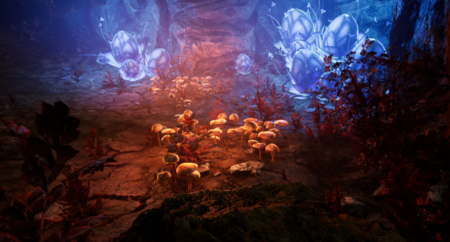
We want our players to have a reason to explore the wilderness, to travel with purpose, and much of that will be driven by our resource system. Transporting these goods might just be more difficult than gathering them. Our regional market system allows players to participate in creating pocket economies that will reinforce the stability of goods in particular regions.[51]
Gatherable resources (also known as raw materials, gatherables, and harvestables) occur in locations where you would expect them to be organically.[52][53]
- Lower level resources will be abundant. Higher level resources that are gatherable by Apprentice level or higher artisans will spawn randomly but in places that make sense for that type of resource. Surveying is a mechanic that solo or group players can utilize to track these resources down.[52]
- We want to be able to spawn stuff randomly and we want to put it in places in the world that will make people travel and bolster up our local player-to-player economies: have people actually be out in the world looking for stuff and not standing in the same place waiting for a tree or a flower to respawn over and over again. So, we're having the best of the both Worlds where we have our lower tier stuff that will fill out the base look of our world, so that it's always looking good; and then the higher tier stuff, from apprentice onward, will always spawn randomly in places that we've deemed look good and make sense for what that thing is. So, surveying is a way that you can track that stuff down. It will help you find places, will help you find particular resources, will help you find resources at a certain rarity; and so it should be something you could do as a gatherer on your own, or group up with other people to bolster up the power of your survey, or the range or reach of it.[52] – Kory Rice
- Certain resources will only be gatherable for a limited time during specific story arcs.[54]
- You want to take advantage of the limited time you have during the story arcs to get some of these rare resources for crafting things.[54] – Jeremy Gess
- Some resources are only gatherable at specific times of the day or night.[59]
- The location the resource was found can affect the benefits, bonuses, and other characteristics of that resource.[60]
- Players drop resources and other items upon death, based on their applicable death penalties.[63][64][65][66]
- Resources looted from caravan wreckages become stolen resources.[67][68]
- Resources do not expire or degrade over time.[69]
- We don't want to create an environment I feel where you're having to micromanage each of the resources that are very vast in our game. We have 100 plus material system where you're having to play whack-a-mole with managing those things... I don't see the value in it.[69] – Steven Sharif
- Rohmaterialien (gatherable resources) are not to be confused with crafting materials (processed goods).[70][71]
Resource quality
Ressourcen will have differing tiers of quality for the same resource type.[62] This is somewhat similar to Star Wars Galaxies.[73]
- Gatherers who are more advanced in their artisan tree will unlock higher level harvesting tools that have a greater chance of collecting higher quality resources or proccing a greater quantity.[62][74][75]
- You will have an opportunity to proc certain qualities based on your progression in the Artisan tree. So if you are a gatherer; and as you advance in your gathering, you'll have a higher opportunity to collect better resources.[75] – Steven Sharif
Ressourcen-Extraktoren
Resource extractors are potential constructions that can collect resources over time.[76][77]
- Available to node citizens who own a freehold near a "resource center".[77]
- Requires several people to construct.[77]
- Moving resources from the extractor will likely require a caravan.[77]
Positionen von Ressourcen
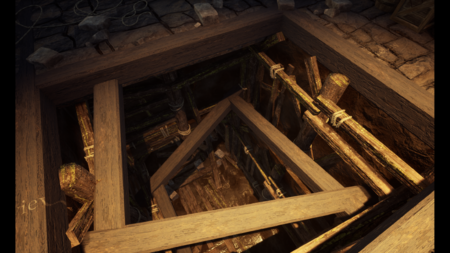
Players will be able to move resources and set up shop in other areas to take advantage of the varied markets. With resources spawning dynamically, certain regions will naturally become important trading hubs for the transportation of goods throughout the world.[51]
The location a resource is found can affect its benefits, bonuses, and other characteristics of that resource.[60]
- Lower level resources will be abundant. Higher level resources that are gatherable by Apprentice level or higher artisans will spawn randomly but in places that make sense for that type of resource. Surveying is a mechanic that solo or group players can utilize to track these resources down.[52][61][62]
- Some resources will exist as a cluster (also called vein gatherables). These will last until the full resource is depleted.[79][61][62][53][80]
- Like a large mine that's present and has a vein of mithril ore in it, or a herd of some type of animal that you can collect fur or wool from.[62] – Steven Sharif
- Once a vein resource is depleted from one location it may respawn in the same location or somewhere else, depending on the type of resource.[62][53][81]
- There will be moving resources such as herds of animals that are constantly moving around the world.[79][81]
- Herds are a source of certain types of wild gatherables but they're in animal form and they're animated; and they exist in a group of the golden fleece sheep that might only spawn very rarely in certain hillsides; and only during spring. And if you can find that vein so to speak of resource you can interact with the herd and you can gather from them.[79] – Steven Sharif
- Corrupted areas house corrupted resources that are necessary components for certain crafting recipes.[82][54]
- Certain types of resources will have a corrupt state... We have a Spirit Bloom, which is a harvestable herbalism plant, but when a Zone becomes corrupt you can potentially yield Corrupted Spirit Blooms; and those are necessary components of certain crafting recipes.[82] – Steven Sharif
- Resources respawn on a cooldown basis.[53]
- Resources won't be locked to the node system.[53]
- Starting resource points may be different on each server.[84][85]
Surveying
Surveying plays a key role in helping gatherers track down and identify resources that spawn in particular locations through the use of surveying tools.[52][13][14]
- Surveying is something that we're trying to use for gatherers to really interact with the things that we want to do with our dynamic world... Surveying is a way that you can track that stuff down. It will help you find places, will help you find particular resources, will help you find resources at a certain rarity; and so it should be something you could do as a gatherer on your own, or group up with other people to bolster up the power of your survey, or the range or reach of it.[52] – Kory Rice
- Surveying can also identify the types of resources that spawn statically within an area and also provides information about the seasons and locations they spawn in.[13]
- Surveying is a way that players can check out an area for resources. Players can learn where resources are that are static and that grow back in the same location; but we'll also have resources and Ashes that can spawn anywhere, so surveying will help players locate those those resources. So if they're looking for something specific they can hunt them down. Surveying will also allow players to uncover hidden resources that players wouldn't be able to see with their with their naked eye. Another thing that a surveying would provide is some of the information that we're talking about before, like for instance if you survey- and inside of your survey area there's plants, you might learn what season that plant likes to grow in. You might learn whether it likes to be watered during the winter versus how it likes to be watered in the summer.[13] – Kory Rice
- Surveying can help uncover hidden resources that are not visible to the naked eye.[13]
- Handwerkliche Entwicklung unlocks higher level surveying tools that enable better identification of gatherable resources within a location.[13]
- Unlocking surveying pylons allows the gatherer to adjust the shape and extend the area of their survey.[13]
- You'd work with a surveying tool; and you set the surveying tool down, and that tool would have a specific area in which it's able to uncover and extract information about the resources that are in the area. As a starting out gatherer you might end up with one of the tools, but as you as you progress and become more proficient with using the tool you might be able to set up additional pylons and extend the area of your survey. That allows you to start making shapes and having more strategic areas that you're surveying. If you could connect multiple pylons to create a shape, maybe you could follow the twisting caverns of the cave. Maybe if you're out in the open like we are here you could just try and make yourself a nice widened shape to scan as much of the area as possible. So it'll be up to the player to be tricky with their surveying tool to try and get the most efficiency out of their survey.[13] – Kory Rice
Land management
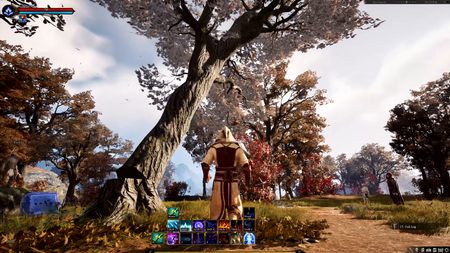
As you draw resources from your surrounding area- what type of effect does that have on the land; and then also how effectively can you draw those resources without having such a deleterious effect on the land, which might impact future resource gathering for some period of time: And it makes relevant the movement of these players who are collecting these goods from the environment, that they actually cannot always just do so in one particular area, as the land management begins to degrade. So it actually encourages movement across the world to discover new areas that might not be as perturbed as the ones you're coming from. It's a very interesting idea. It's something that we're going to be prototyping in Alpha 2 and getting feedback on and testing.[14] – Steven Sharif
Land management mechanics are present for gathering artisans.[87][14]
- The spawn rate of resources in a given area is influenced by how players are interacting with those resources.[87][14]
- Drawing excessive amounts of resources may have a deleterious effect on the land health value for that area.[87][14]
- Actions like ridding an area of invasive species or performing crop rotations on freehold farms may have a positive effect on that area's land health value.[87]
- Defeating certain world bosses or mobs can positively impact the respawn rates of resources and animals in their vicinity.[88]
- It could be could be positive or negative, or both simultaneously. So the land health value ties into the health of a specific ecosystem; and the ecosystem can scale with different segment sizes of the world, or the world itself: A biome, maybe a node, maybe the player's freehold. And the things that a player does in those areas will contribute to health in a positive or negative way. So doing something like rotating your crops might increase the health of the land because that's considered something good to do; and maybe apprehending or removing poachers that are over hunting a certain species could be helpful to the health of the land. Maybe the mayor puts out a request for players to try and get rid of invasive species that are plants- maybe they're overgrowing weed and it's stopping other valuable plants from growing.[87] – Kory Rice
- The spatial inventory system is intended to mitigate the potential for players to diminish land management scores by stripping resources from particular zones.[89]
- There's a particular reason for why that inventory system is intended to exist within Ashes; and part of that is from the aspect of everything in the world is gatherable and there is a land management system that exists behind those gatherable things. The land management system takes into account how players are interacting with the environment: how many of the resources they're withdrawing from the world; and that decreases the spawn rate within certain localities as those things go too high. So there can be a degree of economic warfare by sending players out into zones where you want to mitigate collection of resources. You send your players out there to take all those resources and then that diminishes the land management score of that particular zone.[89] – Steven Sharif
Artisan gear

There's gear for all of the different crafting, gathering, and processing professions that'll help you do those different trades.[91] – Kory Rice
Artisan gear boosts artisans in their gathering, processing, or crafting professions.[91][92][93]
- Profession NPCs sell lower level artisan gear.[94] Higher level gear is crafted by players.[92]
- There are three artisan gear slots on a character's paper doll UI.[90] Previously these was referred to as undergarment slots.[92]
- Artisan gear and adventuring gear do not need to be swapped for either to be effective when they are equipped on a character, but players will be able to toggle gear visibility between their adventuring and artisan gear.[95][90][92]
- If you want to be seen as wearing the herbalists outfit, you're still going to have your adventuring gear present and on the character, and benefiting from the stats that are conferred by them; and vice-versa.[95] – Steven Sharif
- Gathering tools and artisan gear have stats that affect gathering rates and yields.[12][11]
- Gear for artisans are going to live alongside your adventuring gear. So you will currently- the approaches, and we'll test this but currently- the approach is you'll have artisanship oriented gear. This might be beneficial for your gathering; it might be beneficial for your processing, or crafting, or whatever it is- your profession. Essentially you will craft that gear, you will equip that gear, it'll live almost as a undergarment slot so to speak; and then you can activate that and it will show the appearance if you wish during the activation when you gain the benefit from the from the gear itself; and then could disappear afterwards and go back to your adventuring gear. That's the current approach. We're going to play with that a little bit. There's some discussion and disagreement on the team about how we do that, but our hopes are for Alpha two, we will have I think a couple of sets at least. We're demonstrating all of the artisanship from gathering to processing to crafting in limited fashion in Alpha 2 want to have that gear present to play with this approach.[92] – Steven Sharif
Gathering tools
Sammler, einer der Handwerksklassen, benötigen bestimmte Werkzeuge um Ressourcen sammeln zu können.[8][9]
- Fortschritt in der Sammler Handwerksklasse schaltet die Benutzung von höher leveligen Werkzeugen frei, was dem Sammler erlaubt Ressourcen von einem höheren Level zu sammeln.[74]
- Ein Sammler, der das maximale Fertigkeitslevel erreicht, schaltet sogenannte Meister Werkzeugsets frei, welche ihm Zugang zu Ressourcen der höchsten Qualität gewähren.[61]
- Werkzeuge haben eine Haltbarkeit und eine Lebensdauer.[61][97]
- Handwerker müssen sich nicht auf andere verlassen um ihre eigenen Werkzeuge zu craften.[8]
Tools do advance within the artisan tree, so your ability to either gather, process or craft will require the equivalent tools necessary at that stage of crafting in order to accomplish the task at hand. So, you could not mine copper and mithril with the same tool.[9] – Steven Sharif
Das Verarbeiten benötigt Blaupausen für Gebäude, welche benötigt werden, um Ressourcen zu verarbeiten.[8]
- Handwerkskunst benötigt den Erwerb von Rezepten um Gegenstände zu craften.[8]
Gathering tool tiers
Gathering tools for Mining, Kräuterkunde, Lumberjacking, and Angeln are associated with a resource tier.[98][99] For example: A tier 2 axe can gather tier 1 and 2 lumber and no higher.[100]
| Tool rarity | Resource tiers | Vendor price | Vendor location |
|---|---|---|---|
| Common | 1 | 10g | Alpha-1 starting area |
| Uncommon | 1 - 2 | 100g | Expedition (Stufe 1) nodes |
| Rare | 1 - 3 | 500g | Feldlager (Stufe 2) nodes |
| Episch | 1 - 4 | 2000g | Dorf (Stufe 3) nodes |
List of gathering tools
Zeitplan
Handwerksklassen (Sammeln, Verarbeitung, Handwerkskunst) is expected to come online fully in Alpha-2 and the Betas.[101][102]
- Approximately 10 percent of the artisan system was online in Alpha-1.[103][101][102]
- Crafting honestly will not come online in any sense of its true form until Alpha-2. Alpha-1 has essentially what are intended to be the core gameplay loop of crafting, meaning the collection of materials, the translation of those materials into processed goods, and the use of those processed goods into item acquisition. That's the core gameplay loop that is currently present in Alpha-1. But those are mostly facilitated piggy backing the merchant systems right now and not actually using the real crafting system; and that's because crafting hasn't been completed in a form that can be implemented in Alpha-1, but will be for Alpha-2. What's present in Alpha-1 doesn't even really scratch the surface for crafting.[102] – Steven Sharif
Bildmaterial
2023-12-03 2022-10-29 2022-10-29 2020-03-28
Community guides
Siehe auch
Einzelnachweise
- ↑ 1.0 1.1 1.2 1.3 Video, 2022-10-28 (0:47).
- ↑ Video, 2022-10-28 (12:31).
- ↑ 3.0 3.1 3.2 Video, 2022-10-28 (9:19).
- ↑ 4.0 4.1 4.2 4.3 Liveübertragung, 2017-09-03 (10:48).
- ↑

- ↑ Liveübertragung, 2021-07-30 (1:11:58).
- ↑ Liveübertragung, 2023-11-30 (1:58:35).
- ↑ 8.0 8.1 8.2 8.3 8.4 Interview, 2020-03-27 (9:00).
- ↑ 9.0 9.1 9.2 Interview, 2018-05-11 (38:25).
- ↑ 10.0 10.1 10.2 Liveübertragung, 2023-12-19 (1:53:02).
- ↑ 11.0 11.1 11.2 Video, 2022-10-28 (26:14).
- ↑ 12.0 12.1 Video, 2023-06-30 (3:14).
- ↑ 13.0 13.1 13.2 13.3 13.4 13.5 13.6 13.7 Video, 2022-10-28 (10:52).
- ↑ 14.0 14.1 14.2 14.3 14.4 14.5 Liveübertragung, 2022-04-29 (25:16).
- ↑ 15.0 15.1 Podcast, 2018-05-11 (1:00:07).
- ↑ 16.00 16.01 16.02 16.03 16.04 16.05 16.06 16.07 16.08 16.09 16.10 16.11 16.12 16.13 16.14 16.15

- ↑ 17.0 17.1 17.2 17.3 17.4 17.5 17.6 17.7 17.8 17.9 Video, 2023-11-30 (37:12).
- ↑ 18.0 18.1 18.2 18.3 Development Update with Freehold Preview.
- ↑ 19.0 19.1 Video, 2023-11-30 (9:36).
- ↑ Liveübertragung, 2023-06-30 (50:07).
- ↑ 21.0 21.1 21.2 21.3 Podcast, 2023-12-03 (14:14).
- ↑ Podcast, 2023-12-03 (2:53).
- ↑ 23.0 23.1 23.2 23.3 23.4 23.5
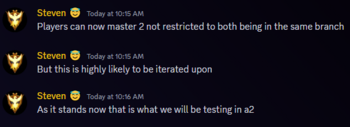
- ↑ Video, 2023-11-30 (23:20).
- ↑ Interview, 2021-02-07 (36:38).
- ↑ 26.0 26.1

- ↑ 27.0 27.1 Liveübertragung, 2022-04-29 (1:13:00).
- ↑ Liveübertragung, 2019-07-26 (1:09:46).
- ↑ Liveübertragung, 2017-05-24 (32:07).
- ↑ Podcast, 2023-12-03 (10:22).
- ↑ Video, 2023-11-30 (26:38).
- ↑ Video, 2023-11-30 (16:40).
- ↑ 33.0 33.1 Video, 2023-11-30 (36:00).
- ↑
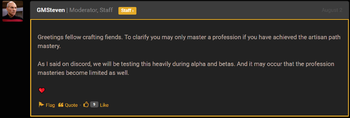
- ↑

- ↑ 36.0 36.1 Podcast, 2023-12-03 (6:23).
- ↑

- ↑ Liveübertragung, 2017-05-10 (6:12).
- ↑ 39.0 39.1 39.2 Liveübertragung, 2023-04-07 (1:00:55).
- ↑ Liveübertragung, 2022-10-28 (1:32:38).
- ↑ Liveübertragung, 2020-07-31 (1:31:11).
- ↑ 42.0 42.1 Podcast, 2023-12-03 (15:05).
- ↑

- ↑ Interview, 2020-07-20 (18:47).
- ↑

- ↑

- ↑
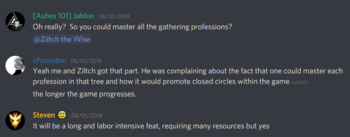
- ↑

- ↑

- ↑ Interview, 2023-07-09 (42:51).
- ↑ 51.0 51.1 About Ashes of Creation.
- ↑ 52.0 52.1 52.2 52.3 52.4 52.5 Video, 2023-11-30 (28:22).
- ↑ 53.0 53.1 53.2 53.3 53.4 53.5 Liveübertragung, 2017-05-08 (54:26).
- ↑ 54.0 54.1 54.2 Video, 2023-03-31 (16:42).
- ↑ Liveübertragung, 2022-05-27 (55:47).
- ↑ Video, 2022-05-27 (15:50).
- ↑ Liveübertragung, 2017-05-08 (20:27).
- ↑
- ↑ Video, 2023-11-30 (34:36).
- ↑ 60.0 60.1 Liveübertragung, 2023-04-28 (1:24:36).
- ↑ 61.0 61.1 61.2 61.3 61.4 61.5 Liveübertragung, 2020-07-31 (1:05:58).
- ↑ 62.0 62.1 62.2 62.3 62.4 62.5 62.6 Liveübertragung, 2020-07-25 (1:04:50).
- ↑ Liveübertragung, 2021-03-26 (1:07:33).
- ↑

- ↑ Podcast, 2017-05-05 (43:05).
- ↑ Interview, 2020-07-18 (27:11).
- ↑ Liveübertragung, 2023-10-31 (1:18:33).
- ↑

- ↑ 69.0 69.1 Liveübertragung, 2023-03-31 (1:19:26).
- ↑ Liveübertragung, 2017-05-05 (34:15).
- ↑ Liveübertragung, 2017-05-10 (8:22).
- ↑ Video, 2023-11-30 (30:19).
- ↑
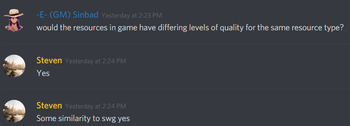
- ↑ 74.0 74.1 Liveübertragung, 2020-04-30 (53:11).
- ↑ 75.0 75.1 Interview, 2018-10-20 (2:13).
- ↑

- ↑ 77.0 77.1 77.2 77.3 Liveübertragung, 2017-05-30 (10:24).
- ↑
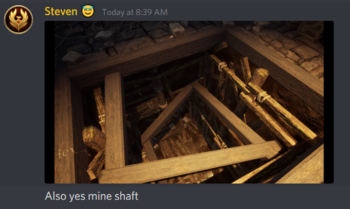
- ↑ 79.0 79.1 79.2 Liveübertragung, 2022-05-27 (1:00:23).
- ↑ Unreal Engine Interview, 2017-05-23.
- ↑ 81.0 81.1 Liveübertragung, 2019-12-17 (1:14:42).
- ↑ 82.0 82.1 Liveübertragung, 2023-03-31 (59:10).
- ↑
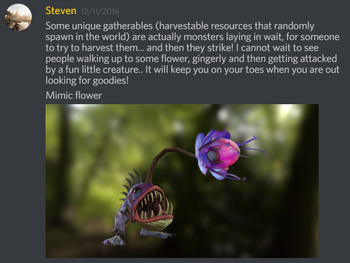
- ↑

- ↑ Liveübertragung, 2017-05-19 (37:03).
- ↑ Video, 2023-06-30 (21:05).
- ↑ 87.0 87.1 87.2 87.3 87.4 Video, 2022-10-28 (14:33).
- ↑ Liveübertragung, 2023-05-31 (42:06).
- ↑ 89.0 89.1 Podcast, 2023-07-15 (22:57).
- ↑ 90.0 90.1 90.2 Video, 2023-11-30 (19:06).
- ↑ 91.0 91.1 Video, 2023-11-30 (5:47).
- ↑ 92.0 92.1 92.2 92.3 92.4 92.5 Liveübertragung, 2022-06-30 (1:17:34).
- ↑ Liveübertragung, 2021-03-26 (1:06:50).
- ↑ Video, 2023-11-30 (12:05).
- ↑ 95.0 95.1 Liveübertragung, 2023-11-30 (1:37:49).
- ↑ Liveübertragung, 2020-04-30 (54:33).
- ↑ 97.0 97.1

- ↑ Video, 2022-10-28 (25:11).
- ↑ Liveübertragung, 2022-10-14 (32:38).
- ↑ Alpha-1 screenshot.
- ↑ 101.0 101.1 Liveübertragung, 2021-03-26 (42:28).
- ↑ 102.0 102.1 102.2 Interview, 2021-02-07 (35:30).
- ↑ Liveübertragung, 2021-04-30 (41:18).
